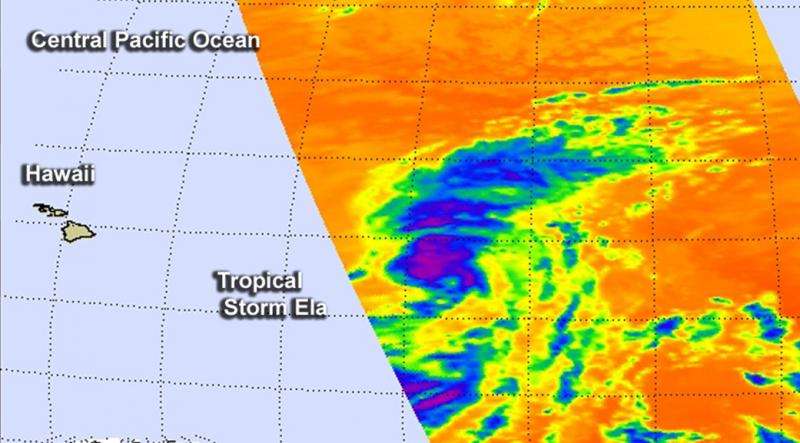Tropical Storm Ela becomes the Central Pacific's first named storm

Tropical Storm Ela was born in the western-most part of the Eastern Pacific Ocean but has become the Central Pacific's first named storm. NASA's Aqua satellite took a look at the storm that's already battling wind shear to survive.
After developing as a depression on July 8, Tropical Depression 4E crossed over the 140 degree West longitude line that separates the Eastern Pacific from the Central Pacific Ocean region. The depression strengthened into a tropical storm early on July 9, taking a name from the Eastern Pacific tropical cyclone list and being renamed Ela.
When NASA's Aqua satellite passed over Ela on July 8 at 22:29 UTC (6:29 p.m. EDT), the Atmospheric Infrared Sounder or AIRS instrument measured the temperatures of the storm's cloud tops using infrared light. That infrared data showed that wind shear from the southwest was pushing all the strongest thunderstorms with the coldest cloud tops to the northeast of the center. The AIRS data showed those thunderstorms in the northeastern quadrant had temperatures as cold as -63F/-52C. Storms that high in the troposphere, the lowest layer of Earth's atmosphere, have the potential to drop heavy rain. Since Ela is far from land areas the rainfall occurred at sea.
On July 9, NOAA's Central Pacific Hurricane Center (CPHC) noted that the latest satellite imagery showed "that persistent southwesterly shear has shunted the mid-level center of the cyclone well northeast of the surface center. However, data from a U.S. Air Force Hurricane Hunter aircraft indicate surface winds near 35 knots in the northeast quadrant. "
On July 9 at 5 a.m. HST (1500 UTC/11 a.m. EDT) the center of Tropical Storm Ela was located near latitude 20.2 north and longitude 146.1 west. That puts Ela's center about 585 miles (940 km) east of Hilo, Hawaii, and about 765 miles (1,230 km) east of Honolulu, Hawaii.
Ela is moving toward the northwest near 13 mph (20 kph) and this motion is expected to continue through tonight. A turn toward the west and a slight decrease in forward speed is forecast for Friday, July 10 and Saturday, July 11. Maximum sustained winds are near 40 mph (65 kph) with higher gusts. The estimated minimum central pressure is 1003 millibars.
The outlook for Ela seems bleak because the wind shear is expected to persist on its track to the west. Ela is forecast to succumb to the shear and gradually weaken today, July 9 and July 10. Ela is expected to eventually dissipate north of Hawaii.
Provided by NASA's Goddard Space Flight Center




















